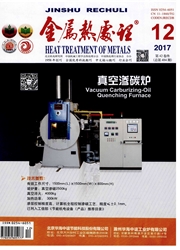

 中文摘要:
中文摘要:
采用电弧熔炼、铜模吸铸法分别制备Ti_(42)Zr_(22)V_(14)Cu_5 Be_(17)、Ti_(46)Zr_(20)V_(12)Cu_5 Be_(17)and Ti_(48)Zr_(18)V_(12)Cu_5 Be_(17)的Ti基内生枝晶增韧非晶基复合材料,利用球-盘式摩擦磨损试验机进行干摩擦磨损试验,研究了枝晶的体积分数对其耐磨性的影响,利用X射线衍射仪分析了样品的结构,利用扫描电子显微镜观察合金的显微组织和磨损表面形貌,分析了不同成分Ti基内生枝晶增韧非晶基复合材料的磨损机理。结果表明在相同的试验条件下,不同体积分数晶体相的非晶复合材料的磨损机理不同。枝晶相体积分数较低时,磨损机理主要体现为轻微的磨粒磨损,随枝晶相体积分数的增加粘着磨损成为主要的磨损机理,同时伴随有硬质颗粒压入软化相构成三体摩擦。材料耐磨性随着晶体相体积分数的增加而逐渐降低。
 英文摘要:
英文摘要:
Three Ti-based bulk amorphous alloys with different compositions of Ti_(42) Zr_(22) V_(14)Cu_5 Be_(17),Ti_(46) Zr_(20) V_(12) Cu_5 Be_(17) and Ti_(48) Zr_(18) V_(12)Cu_5 Be_(17)were prepared using arc melting and copper mold suction casting,respectively.Ball-on-disc friction and wear test were carried out in dry sliding condition.Effects of the volume fraction of the crystalline phase on friction and wear behavior of Ti-based bulk metallic glass matrix(MGM) composites were investigated.The composition of the samples was examined by X-ray diffraction.The structure and worn surface morphologies of the samples were observed by a scanning electron microscope.Moreover,the wear mechanism of Ti-based MGM composites was also analyzed.The results show that slight abrasive wear is the primary wear mechanism of composites.In addition,wear mechanism gradually transforms into adhesive wear with the volume fraction of the crystalline phase increasing to 46%,accompanied by the three-body friction at the same time.
 同期刊论文项目
同期刊论文项目
 同项目期刊论文
同项目期刊论文
 期刊信息
期刊信息
